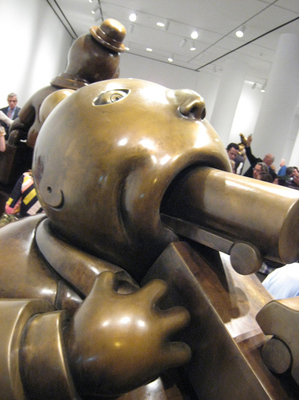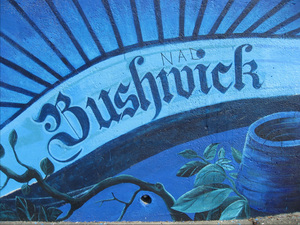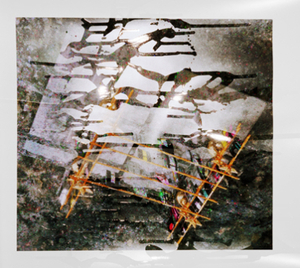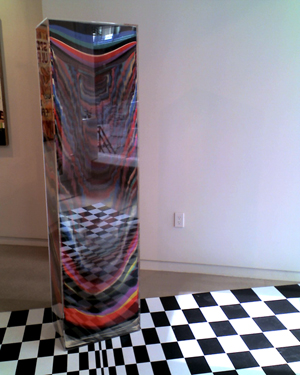This is an archive of the ArtCat Zine, 2007-2009. Please visit our new project, IDIOM.
October 2007
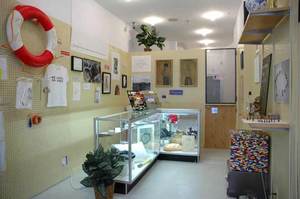
Photo courtesy of e-flux.com
PAWNSHOP
e-flux - 55 Ludlow street, New York NY
1 October 2007 through early 2008
Last month e-flux's Ludlow street location was transformed into a pawnshop as exhibition space, a new project by artists Liz Linden, Julieta Aranda, and Anton Vidokle. For the transformation, some sixty contemporary artists were solicited to contribute works to be pawned — that is, exchanged for a cash value, and kept for 30 days before being offered for sale — which tomorrow become available for purchase to patrons of the pawnshop. The artists who have contributed works include both senior and mid-career artists, some with active collector bases, so much of the works currently on view could well be removed from the space if collectors descend upon the location as it becomes a commercial art distrubution venue. The location has also been aesthetically transformed into one vision of a contemporary American pawnshop, outfitted with pegboard walls, a conventional retail window display, florescent-lit display cases, and an awning that eschews any indication of a commercial or institutional exhibition space.
This functional aesthetic framework does more than recycle an economic model of money lending, barter, and exchange, but also creates the potential for turning unsuspecting patrons into art spectators as they casually wander in to browse the wares. Herein lies the strength of the exhibition, which is complemented further by e-flux's quiet LES location. The historical and critical precedents for this type of relational work are abundant. Nicolas Bourriaud used the model of the flea market to describe a certain strain of 90s art practice in Postproduction. What Bourriaud fails to mention in his text, however, are the artists who set up shop years prior, like Martha Rosler. Rosler provides perhaps the clearest historical prototype to PAWNSHOP with the garage sales she organized in contemporary art spaces in the 70s and later reproduced in the 80s. While Rosler advertised her garage sales both in local general-interest publications and specialized art journals, e-flux's PAWNSHOP lies in wait for unsolicited patrons to enter and engage with the staff on hand, negotiating the established commercial protocol of the pawnshop and the art object. This human element, PAWNSHOP's staff, animates the exhibition and playfully vulgarizes, or, one might even suggest democratizes, the often stiff and financially exclusive world of contemporary art collecting with the contextual application of a well-established and populist economic form.
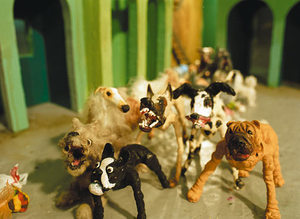
Kids & Dogs), 2007. Courtesy of New York Magazine.
This past Sunday I had the pleasure (and mild pain) of attending the opening night of Swedish artist Nathalie Djurberg's newly commissioned claymation film and performance at the Zipper Theater. Like all of Djurberg's cleverly disturbing, whimsically simple, yet insidiously horrifying, claymation films this one was equally replete with dismembered body parts, graphic violence, gory guts, genitals, and of course a motley melange of dogs, kids, and sexy nurses. Hans Berg and Pascal Strauss accompanied the raunchy action on toy drums, plopping ketchup bottles, pots, pans, household items, slashed cantaloupe, and banging kitchen utensils while lavishly clad in handmade Prada costumes resembling a couture marching band on crack, primly clad with medals of honor and all. Meanwhile Miuccia Prada herself sat among the crowd of spectators who came to see Nathalie's short but sickly sweet performance.
In the Public Eye: The Role of Today's Critic
James Wagner, Barry Hoggard, and Brian Sholis in conversation
6:30pm, 30 October 2007
CUE Art Foundation - 511 W. 25th St, New York NY
$5 for non-CUE members
Window Enactment
A new performance by Tony Conrad
7pm, 30 October 2007
Greene Naftali Gallery - 508 W. 26th St, 8th floor, New York NY 2007
FREE
Tomorrow night at the CUE art foundation in Chelsea bloggers James Wagner, Barry Hoggard, and Artforum.com editor Brian Sholis meet to discuss the shifting role of the critic in the evolving terrain of contemporary art and its supporting industries. Noting the web background of the three participants and each of their own critical practices, it's likely that the talk will gravitate towards the particular possibilities and limitations of hypertext criticism and texts written for and distributed via the net.
Tomorrow night is also another recommended Performa 07 event featuring a live new work by musician and vanguard minimalist filmmaker Tony Conrad. The performance takes place at 7pm at Greene Naftali's gallery space. Because the press release is fairly spare on details, we might look to the artist's previous live works to formulate any reasonable expectations for the latest.
Correction: The CUE listing above previously said 7pm, but it starts at 6:30pm.
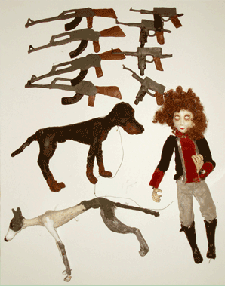
for an upcoming PERFORMA07 Commission).
Photo courtesy of the artist.
27 October - 20 November 2007
New York NY - Various Locations
The Second Biennale of Visual Art Performance launches tomorrow night at the Guggenheim with Franceso Vezolli's
Cosi’ e (se vi pare) or Right You Are (If You Think You Are) a new play — currently sold out, the subject of some controversy as reported on Art Fag City — especially commissioned for the event. Artcal Zine will cover various highlights of the Biennale as they happen through the close of the exhibitions and performances in Novemeber. This weekend also features the launch of video artist and musician Ronnie Bass's PERFORMA TV project — an alternative distribution venue for Peroforma participants and spectators that promises to increase the possibilities of dispersal and archival of content via a live Internet video feed.
Recommended this weekend is Nathalie Djurberg's newly commissioned stop-motion film Untitled (Working Title Kids & Dogs) playing at the Zipper Theatre in Hell's Kitchen ($18) in which packs of children battle packs of dogs, with live music and performance to accompany the screening. Also recommended is Stapelung (stack) John Bock's new five-channel video sculpture opening Saturday on the ground-floor of PS1.
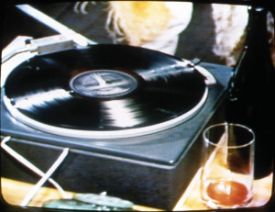
8pm Friday 26 October 2007 Anthology Film Archives
32 Second Avenue, New York NY
$8
Artist and composer Christian Marclay presents his feature length video Up and Out tonight at the Anthology Film Archives. The 1998 work juxtaposes 107 minutes of commercial film image and sound divorced from their original contexts; the former taken from Michelangelo Antonioni's 1966 Blow-Up, the latter from Brian De Palma's 1981 Blow-Out. Marclay's piece mixes cultural forms on a macro level, using entire commercial films as raw material. The tremendous production values of each film used is further obscured (and abstrusely emphasized, in a way) in the work, which transforms both the Antonioni and the De Palma into monolithic signs which Marclay positions in relation to one another so to create the possibility for new meanings. Marclay's piece is a single blunt gesture and not unlike the works of younger contemporaries like Douglas Gordon (24 Hour Psycho) and the socially activated work of photographer Walead Beshty (24 Hour Armageddon Movie Marathon).
Critic Amy Taubin will be at Anthology tonight for a public discussion with Marclay following the screening.
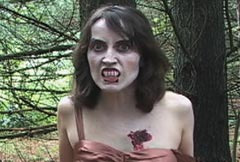
still from two-channel video
Jillian McDonald
Moti Hasson - 535 West 25th Street, New York NY
11 October - 10 November 10, 2007
In Zombie Loop, a two-channel video from 2006, Jillian McDonald positions the viewer between two projections on opposite walls. On one side we see a zombie pursuing the camera, on the other, its intended victim, fleeing. McDonald performs as both victim and zombie, noting: "Locating the viewers physically between the two roles positions them as both the pursued just out of reach of danger, and the pursuer hungering for its prey." A 2007 piece, with the same structure but a different genre — Vampire Hunting is on display, in a sense, in 'Waking the Dead,' McDonald's solo show currently at the Moti Hasson gallery — more on this later.
McDonald's work is fantastic. Her intelligent, sophisticated, and consistently well-executed interpolation of certain, concentrated conceits of representation spans video, photography and performance. Indeed, her work so effectively conjures enough theoretical familiars that it is easy to miss one of its more obviously delightful aspects: it's hilarious. The pieces currently on display at the Moti Hasson bear particular witness to the latter, while the stack of criticism on her website the former. (Of distinct quality is Sylvie Fortin's piece, quoted in the press release.) It is work that is simultaneously accessible and deeply provocative.
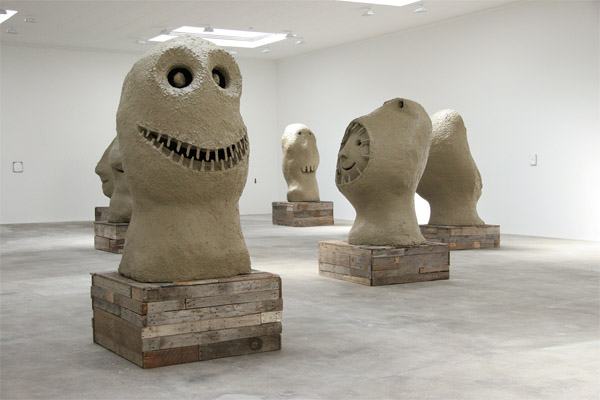
Gallery, New York, September 13 to October 27, 2007.
Big Mind Sky
Ugo Rondinone
Matthew Marks Chelsea - 522 West 22nd Street New York, NY
15 September - 27 October 2007
Small graphite drawings on gessoed linen bound the gallery walls and twelve substantial sculptures rise from the gallery floor in Ugo Rondinone's exhibition, Big Mind Sky, at Matthew Marks. Upon entering the space, viewers gravitate to the large forms, each a disembodied head set atop a wooden plinth. The heads are reminiscent of Easter Island's great moai and ahu constructions, but whereas the Polynesian statues were erected in formation, facing inland from the coast to survey various island chiefdoms, Rondinone's sculptures are arranged arbitrarily. The sculptures may be considered a response to modernism's cannibalism of the "primitive," but the artist titled the series "Moonrise" and named each of the expressive heads after a month of the year; his ambition, I feel, is more profound.
The Public Unconscious
Tom Otterness
Marlborough Gallery - 545 West 25th Street, New York, NY
4 October - 3 November 2007
"He killed a dog, you know."
These words eerily echo through the cavernous chambers of my mind as I start this review. Can you separate the person from the artist? Is it possible to take work for face value without considering the artist?
Early on in the career of sculptor Tom Otterness, he was just another struggling young artist here in Manhattan trying to make it. In the era of the ever-escalating shock value and competitive one-upsmanship of his time — Christopher Burden’s getting shot on camera certainly comes to mind — one of Otterness‘ early pieces involved the adoption of an innocent little mutt, which he then took home and shot dead with a rifle, filming it as it took its last breaths. The video's title? “Shot Dog Piece”.
Art? I ask myself. More like playing God and serial killer at the same time. Fast forward three decades — the Otterness of later years takes center stage at a new Chelsea exhibition, The Public Unconscious.
The show's title touches on how soon we forget the genuinely disturbing actions of the young artist producing abject performance, how that young artist became the Otterness of the mainstream, and perhaps a more general comment on the current disarray in American politics. As an awkwardly coinciding penance, perhaps, this past Friday saw Mr. Otterness go from a former Alphabet City dog murderer to a children's playground sculptor at a dedication ceremony in Manhattan's Lower East Side. His commission was a whimsical frog creature for the kids of the neighborhood to play on.
Can Otterness' current record of public sculpture coerce us into forgiving him, or is his current success a play-by-play book of "Karma Restoration 101?" So now the Gandalf-tressed intellectual of Gowanus has been made accessible to all, via an explosion of the public art commissions that have helped increase his profile and created the Otterness public art brand. He’s even designed a Humpty Dumpty balloon (fashionable stovepipe hat included) for the Macy’s Thanksgiving Day Parade. One really can’t get any more connected to the general public than that.

6-9pm Monday 22 October 2007
The Guild Art Gallery
45 West, 21st Street, 2nd Floor, Suite 39, New York, NY
$50
The South Asian Women's Creative Collective hosts their benefit auction in Chelsea tonight. The silent auction starts at 7pm, with a cocktail reception preceeding at 6pm. Tickets are $50 at the door, and go to directly support the collective. Some 50 contemporary artists have donated works to be auctioned off in support of the organization among which are performance and media artist Coco Fusco and painters Samira Abbassy and Bari Kumar.
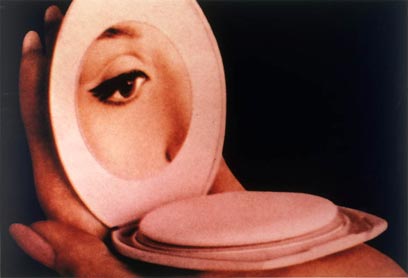
The New Yorker's head art critic Peter Schjeldahl pens a review of the massive Richard Prince retrospective currently going on at the Guggenheim. Schjeldahl bares some rather conservative teeth; he seems as enthused about Prince's 80s media-crit and appropriation work as if little has happened since, but admonishes the artist for his more recent expressive painting and art about art. Opening with an anecdotal story about Prince's refusal to exhibit in the decisive 1977 Pictures show in response to the curator's dogmatism, Schjeldahl relates the story perhaps as some cue to the artist's defiant, and later juvenile, sensibilities. So why does Schjeldahl mind the new work so much? Perhaps he feels a little uncomfortable with the exhibition platform offered to such a decidedly contrary artist, who at one point, happily without representation, had to be convinced by Barbara Gladstone that he might benefit from working with an art dealer. Or maybe he simply doesn't have a taste for the artist's new output. His text-pieces and "joke" art do after all seem uncomfortably similar to some more recent output by Mel Bochner and Sean Landers. Or, perhaps, the critic simply doesn't see the utter hilarity in those hideous, "vulgarized" figure works, evocative of de Kooning only in the most sarcastic sense.
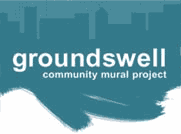
7-10pm Tuesday 23 October, 2007
511 Gallery
529 West 20th St. Suite 8, New York NY
Groundswell Community Mural Project hosts their annual benefit this Tuesday at 511 Gallery. Recent Groundswell projects include the "Time Flies" Bushwick community mural reviewed by Hrag Vartanian on Artcal Zine this week. The benefit is a good chance to support a terrific New York public art organization and bid on work by any one of 60 contemporary artists who have donated pieces to be auctioned off.
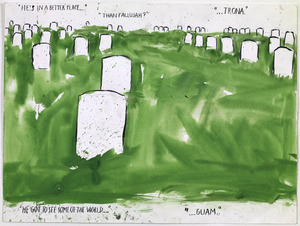
and gouache on paper, 18 x 24 inches.
Courtesy of David Zwirner.
Raymond Pettibon
David Zwirmer - 519 W. 19th St. New York, NY
11 September - 20 October 2007
Raymond Pettibon is one of the first artists I have ever loved and the only contemporary artist I have known about since high school. In the context of SST Records, he helped me arrange my first relationships to power. My own seething over Grenada. Iran-Contragate. Reaganomics. I don't care that Pettibon doesn't like to discuss that part of his career anymore — I can't think about him without vividly remembering the summer I spent watching Oliver North and Fawn Hall take the stand on C-Span in my friend Mark's crappy little studio apartment, my head shaved and finally a set of car keys in my pocket, a Black Flag album cover in my lap. My fists and jaw were probably clenched.
I love Raymond Pettibon because he understands the existential weight of having to take it all in. Everything from the comic-book format to the way his individual drawing refuses to turn into anything more than a scrap of inky paper confirms that he is not special, not a genius. He is just someone who watches the world, and the world makes him sad and mad and desperate. This sadness and desparation — punctuated by occasional glimmers of hope reflected in the lonely soul of the individual — is meaningful. And it's totally punk rock. Still. The message in Here's Your Irony Back (The Big Picture) is the same as the overwhelming lesson of the eighties, of Jello Biafra and Henry Rollins. You can see exactly what these fucks in power are doing. And you can do more than talk about it. You can scream your fucking head off about it. You can get really angry. You can put safety pins all over your face and your pants and you can dance powerfully and tribally about it until you are a drunken, soggy heap, and you will be beautiful and meaningful. You will, in that moment of total writhing expression, make perfect sense in relationship to the rest of the world.
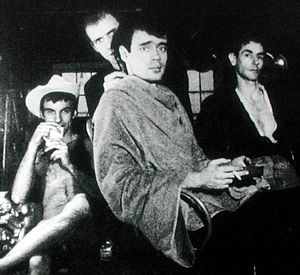
Waring in Andy Warhol's "Haircut #1," 1963,
still from b&w film in 16mm, 24:00
Museum of the Moving Image
35 Avenue at 36 Street Astoria, NY
20 October - 11 Novemeber 2007
Starting this weekend and continuing every Saturday and Sunday through 11 November, the Museum of the Moving Image in Queens presents an extensive selection of works on film by Andy Warhol, and a few filmmakers since making works with or about ex-Factory stars.
Many of Warhol's shorter minimalist films playing this weekend deliver exactly what their titles promise — Haircut #1 (2pm, 20 October) tests our patience as one man cuts another's hair, only to be interrupted near the end of the film by two other scantily-clad men drawing our attention away with a series of provocations; Kiss (2pm 20 October) has 54 minutes worth of close-up kissing couples, both same- and opposite sex; in Eat (7pm 21 October) we see a slightly-starved Robert Indiana affectedly eat a mushroom; Couch (4pm Saturday) is one of Warhol's more sexually provocative works staring celebrated American writers Allen Ginsberg and Jack Kerouac; Blowjob (6:30pm 20 October) is remarkably less provocative; Screen Tests: Reel 16 (2pm 21 October) includes portraits of writer and critic Susan Sontag, musician Lou Reed, and American avant-garde filmmaker Jack Smith, the last of which was once described by Warhol as "the only person I would ever copy."
This Sunday at 5pm, the Museum also hosts The Warhol Gaze, a discussion between Warhol Film Project curator Callie Angell and the critic Amy Taubin.
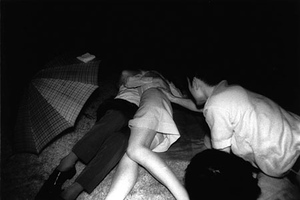
Courtesy of Yossi Milo Gallery.
Kohei Yoshiyuki
Yossi Milo Gallery - 525 West 25th Street New York, NY
6 September - 20 October, 2007
If you have read anything about Kohei Yoshiyuki’s show The Park, currently on view at Yossi Milo Gallery, you know the basic story — that Yoshiyuki went about photographing young lovers coupling in Toyko’s public parks and the many men who watched them do it. As told to The New York Times columnist Philip Gefter, the story goes that one night in the early 1970’s while innocently photographing lit skyscrapers, Yoshiyuki strolled through a local park and happened upon a group of men secretly watching a couple fool around. The couple seemed unaware of the rapt audience and went about their business unperturbed. Intrigued, Yoshiyuki decided to shift the focus of his camera lens away from the steel phallus to real phallus. After spending months infiltrating and observing these clandestine gatherings sans camera, Yoskiyuki began documenting the events without disrupting the lovers or the peeping toms, using a film camera outfitted with an infrared flash.
The Park series captures two of photography’s most salient characteristics: photography is both a documentary and voyeuristic medium. The original presentation of The Park focused more attention on its voyeuristic aspect than does the show at Yossi Milo. When Yoshiyuki showed the work in 1980 he printed the photographs wall sized, turned off the lights in the gallery, and equipped gallery goers with flashlights to view the images in order to replicate the experience of being in the park — he was quoted in The Times saying that he wanted viewers to have to look at the bodies “inch by inch.” For this show he printed the images at a modest 16 x 20 inches and displayed them documentary style, in a neat line, one abutting the other. Though this show is less salacious than its predecessor, the original presentation was more honest about the audience’s relationship to the photographs. The act of looking at these photographs is voyeuristic. We should revel in that, not pretend as if we can maintain a cool distance.
Created by artists and students from the Academy of Urban Planning, El Puente Academy, and Groundswell Community Mural Project, the mammoth project was under the direction of muralist Joe Matunis and continues a tradition that has long been a Bushwick tradition — community murals.
In 1992, an earlier mural stood at this otherwise quiet corner and symptomatic of the time, it confronted issues of drugs, crime and social justice--which grappled this community.
Fast forward to 2007 and Bushwick has changed from the front lines of the city's drug wars to the next up-and-coming neighborhood. While the new wave of highly-educated hipsters homestead in this north Brooklyn neighborhood, "Time Flies" is one of the first public efforts by the predominantly black and Hispanic citizens of Bushwick to articulate their own thoughts about the neighborhood's future.
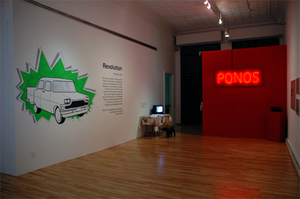
Courtesy of apexart.
Curated by Antonia Majaca and Ivana Bago
apexart - 291 Church Street, New York NY
19 September - 3 November 2007
Too often the works in thematic exhibitions have a predictable sameness to them. The theme provides a narrow focus, with one work after another conveying a similar take on the subject. The current show at apexart, Stalking with Stories, is a welcome change. Curated by Antonia Majaca and Ivana Bago, the works are unified through their consideration of nostalgia and memory, while each piece plays with the friction between stories known to a group and the individual experiences of those stories. What can be revealed and what is left out vary considerably from artist to artist. These investigations into narrative collectively manifest its elusive and shifting nature.
Felix Gmelin’s video installation, Farbtest, Die Rote Fahne II, includes two monitors. One shows a red flag being carried through the streets of Berlin in 1968; the other depicts a recreation of this performance in 2002 Stockholm. Though the political landscape of a walled Berlin provides the backdrop for the earlier video, so does the knowledge that the artist’s father appears in the Berlin video. Divorced from the 1968 context, the younger Gmelin’s inhabiting of the past strips substance from the action, suggesting the impotence and emptiness of parroting historical acts of social protest.
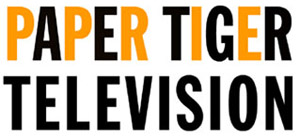
7pm & 9pm, 15 & 16 October 2007
Anthology Film Archives
32 Second Avenue (at E. 2 St) New York, NY 10003
$8
In celebration of their 25th anniversary, progressive downtown media organization and one-time public access channel Paper Tiger Television hosts two nights of programming at the Anthology Film Archives. Over the years, PTTV has helped hundreds of New York media activists, students, art historians, video artists, and others produce videos with various goals and for various audiences. They are mostly known for the culturally critical documentary tapes with a certain PTTV-look that eschews slick production values for a sense of artistry and play. Recommended tonight at the 7pm screening is sociologist Herb Schiller's 1981 tape Herb Schiller Reads the New York Times: The Steering Mechanism Of the Ruling Class, which delivers on its titular promise. The video is an early manifestation of a video "reading" genre that PTTV pioneered. The form is one in which an intellectual or artist performs a critical, something theatrical, reading of a popular cultural publication, usually with the intention of deconstructing the language of the text and exposing the transparent constitutive ideologies in the process; Tuli Kupferberg of the Fugs made a tape reading Rolling Stone for the series in 1982, Martha Rosler reading Vogue in 1982, Alex Cockburn reading the Washington Post in 1983, Noam Chomsky reading the New York Times in 1986.
Tomorrow's show at 7pm focuses on tapes dealing with race and class in New York, and includes Tompkins Square Park: Operation Class War, a 1992 documentary on the now deeply entrenched class divides of a then-gentrifying Lower East Side. The 9pm program features several tapes centered on LGBTSTQ perspectives, including Fenced Out, a 2001 documentary on the legal struggles for Christopher Street Pier, a long-established safe-haven for lower-income and homeless lesbian, gay, bisexual, Two Spirit, transgender and questioning youth of color and an important 60s historical site of the modern gay liberation movement.
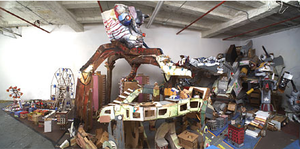
mixed media installation (detail).
Courtesy of The Front Room gallery website
7pm, Friday 12 October 2007
(every second Friday of the month)
60 North 6th Street, 2nd floor, between Kent and Wythe,
Brooklyn, NY, 11211
FREE
Williamsburg Every Second
Friday, October 12th, 6-9pm
(every second Friday of the month)
Various locations
FREE
Artist collective MTAA launch Over the Opening tonight, a new project in which the group showcases the work of an artist every second Friday of the month in their Williamsburg studio. Media artist and MTAA member Michael Sarff's starts things off by presenting three video loops from the Again Transporter series, exploring the nature of servomechanisms and mechanized transportation. The artist will also show Some Group Assemble Required (SGAR), a socially activated sculpture.
A number of Williamsburg galleries remain open past usual closing hours tonight for Williamsburg Every Second, a monthly event allowing strollers to look at art after-hours. A recommended stop tonight is The Front Room on Roebling, where Ethan Crenson will be spinning 78 rpm records from his collection of atomic bomb songs and Cold War classics tonight, while Mark Stilwell's cityscape installation looms in the background.
Carsten Nicolai at Pace Wildenstein
534 West 25th St., New York, NY
October 5, 2007 — November 3, 2007
Fuck drugs. Carsten Nicolai has been altering my brain on a cellular level with his sounds for over ten years now. I was well-chuffed when I heard about his exhibition of sound and visuals at Pace Wildenstein on 25th Street. I've read about his installations, but I haven't had the pleasure of experiencing them first hand. His sound work has always reminded me of the vibrant edges of a Jo Baer painting from the 60's or 70's, dealing out perceptual challenges both beautiful and expansive in their simplicity and directness.
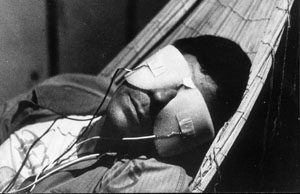
Documentary photographer and filmmaker Danny Lyon presents a reading from his latest book Like a Thief's Dream at the Whitney, Friday 12 October. The artist has been known for his "New Journalism" photographic practice as well as his montages and occasional films — the best known of which center on renegade bikers and prison inmates.
In conjunction with Staring Back, Chris Marker’s current photo show on view at the gallery, Peter Blum in SoHo will be screening several films by the artist. Tonight at 7pm The Sixth Face of the Pentagon (1968), The Embassy (1973), and À Bientôt J'Espère (1967) will be shown. All three films, the second a fiction and the other two documentaries, are about the uncertainties and potentials of social political struggle. On Thursday, 18 October, the gallery will screen the Marker’s highly formative sci-fi dystopia La Jetée (1963) and Remembrance of Things to Come (2002), Marker’s more recent documentary effort — both films are almost completely composed of still images.
Next Wednesday, 17 October, the Guggenheim will host "Reagen-Era America", one of several panel discussions presented this month along with “Richard Prince: Spiritual America.” The panel's titular topic will discuss the political and cultural climate of the late 70s and early 80s, and will be moderated by Johanna Burton; participating commentators will be critics Todd Gitlin, Isabelle Graw, Julia Bryan-Wilson, and Gil Troy.
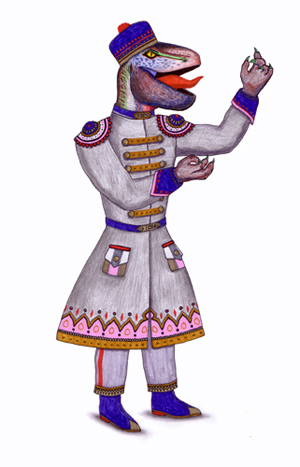
white china marker on grey green tinted paper, 17 x 35 inches.
Courtesy of Klaus von Nichtssagend
Jenny Ping
Klaus von Nichtssagend Gallery - 438 Union Avenue Brooklyn, NY
21 September - 28 October, 2007
The Klaus von Nichtssagend Gallery is a true artists' gallery, upholding the fervent sensibilities of the practitioner-proprietors whose love for art and their fellow artist colleagues begets some brilliant exhibitions. The "nicht" in the Nichtssagent literally means "nothing." The owners, RISD grads fed up with the stale state of affairs in the art world, wanted to see artists up that they simply weren’t seeing. In the spirit of artistic progress and creative ingenuity, they joined forces and started their own exhibition space that they aptly dubbed with the most pretentious sounding name they could imagine, equally offset by its own ridiculous non-meaning. The only rule at the space is a refusal to show their own work in order to mitigate the already painful tendencies of the art world's blatant self-indulgence. The name of the space was their clever antidote to the dilemma of artists showing artists. Call it a wink at the art historical -isms and self-reflexive considerations all their favorite German authors and professors taught them (I miss you, Buchloh!). The three founders and co-directors, Sam Wilson, Rob Hult and Indgrid Bromberg Kennedy, call it a "labor of love." Located just off the Lorimer stop in Williamsburg, the Klaus Gallery sits conveniently next to Dumont where the strategic placement guarantees pre-brunch art viewing.

Folks
Michael Cline
Daniel Reich Gallery - 537 W. 23rd St., New York NY
September 15 - October 20, 2007
Unknowing Man's Nature
Jules de Balincourt
Zach Feuer Gallery (LFL) - 530 W. 24th St., New York NY
September 6 - October 13, 2007
First, I want to applaud both Michael Cline and Jules de Balincourt because they are aiming at something grand, or at least larger than themselves. This represents a real risk that should be acknowledged! Art with content in Chelsea tends to be about defining the individual artist, rather like using your hobbies to define yourself on your Myspace page. Matthew Barney is perhaps the most extreme example of this self-involved bricolage. Barney’s interest in everything from tea ceremony to the Isle of Man becomes a small piece in his baroque self-myth, and this self-myth, or brand, is his intellectual project.
Instead of working exclusively in terms of defining themselves, both Cline and de Balincourt are working to understand the world we all share — they are facing out instead of in. It's hard to reach past the self in this culture, especially when there is so much freaking money at stake in Chelsea.
It's also hard, after getting your average MFA training, to envision how to effectively reach past yourself and engage more than your own backyard of personal interest; whether it's trashing hotel rooms in a coke-induced stupor, or something more wholesome like surfing. We can all be honest and admit that as MFA candidates we were taught to think of ourselves as very interesting people, but that in fact what is interesting right now is just how fucked up the world might be.
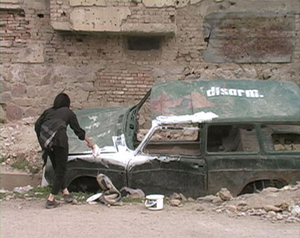
Image courtesy artist's website
Lida Abdul in conversation with curator Pieranna Cavalchini
7pm, Tuesday 9 October 2007
Location 1
26 Greene Street (between Canal and Grand)
New York NY, 10013
FREE
If we were to describe the video and performance artist Lida Abdul as some of the high-profile international exhibitions which have shown her work are likely to do — that is, by the artist's national or ethnic identity, like a denomination inspired directly from a Miss America-style beauty pageant — we might say she is an Afghan-American artist who makes work about the ruins of personal and collective national histories. We might also resist the temptation for such simple reductions, a critical stance especially useful in discussing Abdul's work in particular, as some have described the artist as "post-identity" or "post-nation." Even this characterization, however, leaves the artist with a certain unease.
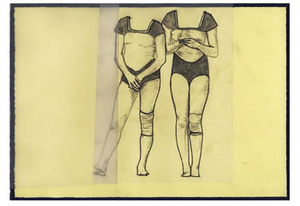
on stationery. Courtesy of AFEW
The gallery showcases new and emerging artists in monthly solo shows. The work featured on the site is primarily two-dimensional — including drawings, paintings, photography and embroidery. This December, the “Back Room Inventory” feature launches which will allow those interested to buy select pieces from past shows.
The current show on the site is by Canadian artist Sarah McKiel. The artist exhibits a series of mixed-media drawing depicting images of women and female sexuality via the representational lens of the media. The show includes pictures of a topless Anna Nicole Smith, Tara Reid with a breast falling out of her shirt, headless gymnasts, bikini car washers, and Jon Benet Ramsey. McKiel’s work consists of clean line drawings, frequently adorned with embroidery for emphasis. Her piece “Jon Benet” gives me the creeps. I can’t look at it with out thinking of a certain Julie Ruin lyric: “Jon Benet didn’t scream ‘cause she never fuckin was.”
Recently I was having lunch with five other young woman artists and designers. Over the course of our meal it was revealed that four of the six of us were medicated for anxiety, depression, or both. I’m pretty sure this isn’t a coincidence. So, when you can’t bring yourself to hike into Chelsea and look at boring art by some white dudes, you can log on to AFEW to view the current show and browse images of past shows. Also, you may actually be able to buy one of the pieces without breaking the bank! How cool is that?
FULL DISCLOSURE: I was lucky enough to be asked to do the November show on AFEW.
A good deal of calories later, helmet on head and smile on face, I went to my first exhibition at Brooklyn Fire Proof titled “Post Retro.” The exhibition examines the reassessment of trends and styles when they are seen in retrospect; like when something dead and gone suddenly resurfaces (think bell bottoms) and a present trend owes its tendencies to a retro influence that is often re-used and recycled. This notion, of course, applies to fashion and cultural tastes as well as to art. My full belly needed to digest much like this rather complex curatorial theme; both were loaded and full of diversity. Filled with cultural references to our society of plenty in desire for more, this show offers a veritable smorgasbord of art, replete with bright colors, clever installations and a really cool photograph by Carter Mull that presents the messy wasteland of the present. Mull’s nearly obsessive abstractions are assembled collages of little bits of what can be detritus, scattered about in cluttered chaos yet put together in perfectly constructed cohesion. His piece evokes our rambunctious lives, replete with noise and dissonance but always somehow aligned and composed to give the illusion of structure.
A Muzzle of Bees
Curated by Tom Brauer
33 Bond - 33 Bond St, New York NY
6 September - 13 October 2007
The press release of A Muzzle of Bees, a group show curated by artist Tom Brauer currently on view at 33 Bond, promises to offer strategies to “fight loneliness, isolation, and seclusion” — all topics related to the titular Wilco song and the 2004 album on which it was released. Some artists in the show do this better than others, but all seem to take an introspective approach, seeking out answers to the aforementioned loneliness from the insides of their studios, within the comfortable perimeters of studio practice. Lisha Bai, for instance, turns to art history and industrial processes with her clever sculptural installations, one a clear acrylic rectangular box filled with layers of dyed sand, the other a checkered floor mat. The latter piece in particular is a success, at once employing a sort of easy Bridget Riley reference while subverting the preciousness of the historical work by the fact of its material composition: linoleum — an inexpensive material commonly found lining the floors of pre-50s offices and kitchens, and sometimes entire lower-income apartments. Installing this it on the floor of the gallery itself, Bai invites viewers to step all over the work.
Oceans Between Us
Adam Ogilvie
Josee Bienvenu Gallery
20 September - 27 October 2007
The geology of Adam Ogilvie's candy-pop colored landscapes is all marshmallow and lollipop, but a palpable unease pervades his work. In "Wishes for a Wiser time," grey smoke puffs from a volcanic mountain into the pink sky; are these signs of impending eruption? A parachute drops behind a broad hill in "Homes become Hollows, Hollows Become Home," the pilot unseen and unaccounted for; what has happened? In "Fjord," fighter planes sit unattended on quiet plateaus; will they be manned and, if so, to what end?
The inhabitants of this anxiety-ridden world are "MOLEBEARBIRD - burrower, fighter, flyer and hibernator" and a cast of related characters wearing capes, dragging great rocks, and generally going about the business of the absurd. Ogilvie also includes in the exhibit cardboard-and-screw sculptures of these anthropomorphic creatures. Removed from the context of the paintings, the blank-faced sculptures might read as ambivalent totems to our existential folly, but here these creatures appear hopeful, if pensive; they are determined to make the best of every rolling of the bones. Like Camus's Sisyphus, "the struggle itself is enough to fill" these creatures' hearts.
Welcome to the ArtCal Zine — ArtCal's new, artist-run publishing effort. Here you'll find reviews of New York shows, features, editorials and interviews by an expanding group of artists and art writers. We'll also be featuring New York event listings that don't exactly fit into ArtCal's exhibition database but are worthy of note.
ZINE
HOME
TIPS / COMMENTS
CATEGORIES
CONTRIBUTORS
- Greg Afinogenov
- B. Blagojevic
- Adda Birnir
- Susannah Edelbaum
- Julie Fishkin
- Paddy Johnson
- Jessica Loudis
- Christopher Reiger
- Andrew Robinson
- Peter J. Russo
- Blythe Sheldon
- S.C.Squibb
- Hrag Vartanian

